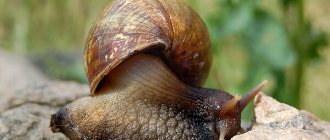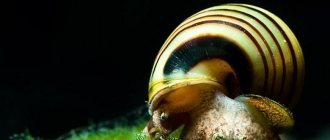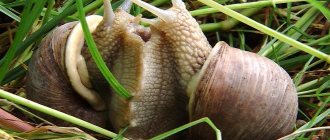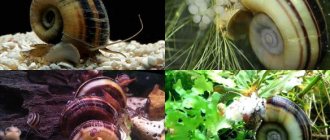Description
Ampularia is a large species. Pet stores sell young specimens with a diameter of up to 2 cm; after a year, the aquarium pet grows up to 10 cm, and in natural conditions the mollusk reaches 15 cm. In the natural environment, the snail lives 3-4 years, in an aquarium - about 2 years.
Ampularia is a snail belonging to the family of gastropod lungfishes Ampullariidae, order Architaenioglossa. Breathing is gill-pulmonary, the gills are on the right side, the lungs are on the left. Inhalation of atmospheric air is carried out by a siphon - a tube-shaped organ.
External characteristics of the type:
- Large twisted shell with a diameter of 7-10 cm;
- Long muscular leg for crawling;
- The sink is closed with a hard lid in case of danger;
- There are small yellow eyes on the head;
- Olfactory organs – 4 antenna-tentacles;
- Mouth apparatus - radulas-scrapers for scraping off organic matter.
The ampularia is capable of regenerating: having lost any part of the body, it grows back.
The most beautiful detail in describing the appearance of a snail is its shell. The natural color of the shell surface is brownish-yellow. But today in pet stores you can see white, black, blue, bright yellow, and purple individuals.
Pomacea diffusa Blume, 1957
Who and where from
Pomacea diffusa
is one of the best known members of the fairly large family Ampullariidae, most commonly found in aquarium cultures around the world.
And in nature, these freshwater snails live in the Amazon basin. Pomacea diffusa
initially described as a variety (subspecies)
of Pomacea bridgesii
(Reeve, 1856), distinguished by its slightly smaller size and wider geographic distribution (almost throughout the Amazon basin).
Later, mitochondrial DNA analysis showed that Pomacea diffusa
and
Pomacea bridgesii
are two separate species.
One type - different names
Aquarists usually call snails of this species simply ampularia (as well as “ampoules”, etc.). As for the Latin name, Pomacea diffusa
, and such erroneous names as
Pomacea bridgesii
(see above) and
Ampullaria australis
(southern ampularia).
In English-language literature and Internet resources you can see such names as apple snail (apple snail, used for the entire family Ampullariidae), mystery snail (mystery snail). The Germans call this species spitze Apfelschnecke, which can be translated as “spicy apple snail.” Moreover, the adjective “sharp” characterizes the shape of the shell’s curl, or more precisely, its difference from other species of the genus Pomacea
, which are also sometimes kept in aquariums. More details can be found on the website https://www.applesnail.net (see Russian version of the main page).
Appearance
The shell of this species is quite large, can reach 4–5 cm in diameter and 4.5–6.5 cm in height. The curl is high. The whorls are so convex that they look stepped. The coloring of both the shell and the body is quite variable, which made it possible to develop various color forms (we will tell you more about them below). The "wild form" has a brownish shell with darker spiral stripes. Since about 1960, the yellow form has also been known - with a stripless shell of a rich yellow (or even yellow-orange, gold) color, which has almost completely replaced the brownish-striped ampularia in pet stores. Body color is also variable, from very light (white, cream) to dark gray, actually black. Moreover, mollusks with a grayish head and leg may also have bluish tints. Pinkish-orange spots (somewhat reminiscent of freckles) are often clearly visible on the body.
Colored ampularia
Nowadays on the Internet you can increasingly see photographs with very beautiful, multi-colored ampularia. Sometimes the colors in such photographs look too bright and artificial, which leads many to think that the sold snails are artificially colored with food dyes (by injection or regularly adding dyes to food or water). Reviews from people who bought such a colorful miracle also differ sharply: some snails died almost immediately, while others live happily and reproduce. For some, the colors quickly “faded,” causing understandable disappointment and even indignation in this case, for others, the snails themselves remained colorful and produce colored offspring. What can I say? I would like to advise you not to buy snails that are too “poisonous”, have unnatural colors, and even from random people. And before buying, see what the different colored forms of ampullaria that have been bred (more precisely, selected from random mutations) recently look like in reality. This can be done, for example, on this German site: https://www.heimbiotop.de
And it is also important to remember: when we look at the shell of a living snail, we often see the color of its body (mantle, as well as the internal or visceral sac) visible through the walls of the shell. The combination of “body color” + “shell color” can sometimes give the most unexpected results. For example, a gray body in a white shell gives the illusion of a blue or at least bluish shell. But with age, the walls of the shell thicken, the body is no longer so translucent, and an adult snail with a whitish shell and a gray body can grow from a charming “bluish” young snail. By the way, on the mentioned German website there are photographs of young and adult snails of different color forms for comparison.
Not yet having the opportunity to show our readers photographs of different color forms of ampullaria (except for the original brown and widespread yellow), we will still list them (based on the same German site).
Brown.
The color of the shell is similar to the natural form. The shell is brownish, with darker spiral stripes. Body white to cream. Previously it was the most common form in aquariums.
Yellow.
The shell is yellow to light brown in color, without spiral stripes.
The body is white. This color form has been known since approximately 1960. There is evidence that it was first obtained (or rather, selected) in Florida, and then spread in aquarium culture around the world. Today it is the most common color form of Pomacea diffusa
. In English-language Internet resources it may be referred to as “golden mystery snail” (golden mystery snail).
Brown-blue.
One of the rare forms. Body bluish-gray to black. The shell is brown and striped.
Yellow-blue.
The shell is yellow, without stripes. The body is more or less intensely bluish-gray to black. Because in young snails, the dark body is strongly visible through the still thin shell; they are also called “green” (or olive - in Russian-language Internet resources).
Blue.
Body bluish-gray to blue. The shell is white. In young snails it is still thin and translucent, so it appears blue.
Lilac or violet.
Body gray to blue. The shell is purple (more like a very light purple in the photos shown) with pinkish-brown spiral stripes. In domestic Internet resources this form is called “blueberry”.
Pink.
The body is white. The shell is pink with darker pink stripes.
White.
Both the body and shell are white. In domestic Internet resources this form is called “pearl”, in English - “ivory snail” (ivory snail).
Those who want to start breeding multi-colored ampularia are recommended to keep each color form separately to avoid “mixing” them. In any case, you need to be prepared for the fact that the offspring of “colored” parents may also have brown offspring, similar to their “wild” ancestors.
Lung snails
What else is interesting about ampularia besides color variability? Of course, an original way of breathing, which can be called “combined”. As is known, marine and some freshwater snails breathe with gills (more precisely, most often with one unpaired gill). The second, and rather large, group of freshwater snails breathes atmospheric air using the lung - a modified mantle cavity. Their distant ancestors once walked onto land, and then returned to the water again, while maintaining the pulmonary type of breathing. Therefore, they are also called secondary aquatic mollusks. But ampullaria have a unique adaptation that allows them to successfully survive in swamps and other shallow standing reservoirs, the water of which is poor in dissolved oxygen. Their mantle cavity is divided by a septum into two parts: one contains a gill, the other can function as a lung. When the snail needs to “inhale” atmospheric air, the edge of its mantle extends, forming a long tube (siphon). In this way, the snail can breathe without rising to the surface of the water, where predators may be waiting for it. When shallow water bodies dry out, the ampullaria are buried in the bottom silt, cover the mouth of the shell with a lid located at the end of the leg, and can plunge into “hibernation” for a long time.
What's in the aquarium?
Ampoules are kept in aquariums not only for their beautiful appearance and interesting behavior, but also for cleaning the walls from algae fouling. True, effective cleaning is achieved only when the snails are kept “on a starvation diet”, and they do not have the opportunity to eat fish food in large quantities. Unlike other members of the family Ampullariidae, also sometimes kept in aquariums, Pomacea diffusa
can only feed on relatively soft food, so it cannot cause so much harm to the vegetation planted in the aquarium.
Especially if this vegetation has fairly hard leaves. Much more dangerous for plants, for example, is the similar-looking Pomacea canaliculata
. These two species can be distinguished by the shape of the shell, which is clearly shown on the website https://www.applesnail.net (see the Russian version of the main page).
Since Pomacea diffusa
cannot eat too solid food, it is recommended to feed them with tableted fish food, boiled vegetables (for example, boiled cabbage leaves), etc. However, we are not going to describe in detail here the features of feeding and maintaining ampularia; there are special sites for this.
Another interesting biological feature of Pomacea diffusa
(and some other representatives of the Ampullariidae family) can be observed in the aquarium (of course, if it contains both male and female ampullaria). The fact is that females come out of the water to lay eggs. Therefore, the masonry turns out to be attached to objects located above the surface of the water - plants, stones, etc. In captivity, the walls or lid of an aquarium are often used for these purposes.
Care and maintenance
Ampularia are social mollusks, so 4-6 individuals are bought for an aquarium. Since representatives of the species are large, a minimum of 10 liters of water is required per individual. Therefore, a group of 4 snails requires a tank of at least 40 liters.
Sometimes snails insistently try to crawl out. This behavior is associated with the sensitivity of the ampoule to maintenance and care. Unfavorable parameters and poor water quality are the main reasons why ampularia die. To prevent pets from getting out and crawling around the room, it is necessary to equip the tank with a lid, but do not close it completely, since snails need atmospheric air.
Water parameters
For the full existence of yellow snails in the aquarium, it is necessary to carefully monitor the water parameters:
- Temperature – 23-25°C;
- Acidity – 6.5-7.5 pH;
- Hardness – 8-18 dH.
It is unacceptable to keep snails in soft water: this will lead to the destruction of the shell, since minerals are required for the formation of hard tissues. How long ampularia live in an aquarium depends on the temperature: in water below 20°C death occurs instantly; at constant values of 25-27°C, life expectancy is reduced due to accelerated metabolism.
Snails are brought in to clean the aquarium, but they are voracious and leave a lot of food waste after feeding, so a powerful filtration device is required. It is also necessary to install a good aerator and regularly siphon the bottom.
Ampoules in an aquarium tolerate being kept in slightly salty water.
Lighting
Snails are indifferent to lighting, but do not experience discomfort if artificial light is turned on above the aquarium.
Plants
Hungry ampularia can eat tender plants, so it is better to plant hard-leaved species:
- Cryptocoryne;
- Vallisneria;
- Anubias.
Priming
The best options are sand or round pebbles. Rough soil with sharp pebbles cannot be used: pets will injure the soft body.
Decor
When arranging an aquarium, the breeder is guided by his own taste; the snails do not care what their home looks like. It is advisable to put shells and limestone fragments on the bottom to increase the mineralization of the water.
How to breed ampoule
It has already been noted that representatives of this species are heterosexual; in order for them to reproduce, a couple consisting of a female and a male is required. To get one, you will have to purchase 5-6 individuals at once, this is the only way to guarantee the heterogeneity of the pets.
When the snails reach sexual maturity, they will begin to reproduce on their own and will not require any external stimulation. Moreover, they give birth at any time of the year, although more often in summer than in winter. If two individuals merge with each other, then mating is taking place. Typically, the top clam is male.
After mating, the female emerges from the water and begins to lay light pink eggs above the water surface. They should not be immersed in water, otherwise they will disappear. When exposed to air, the outer shell of the eggs calcifies, and the offspring are safe.
After a few weeks, small snails emerge from the eggs, but this requires sufficient humidity and a temperature of 21° to 27°C. Only the offspring that are born are well developed and do not need additional care.
Feeding
The aquarist decides whether snails are needed in the aquarium, but ampularia can become an additional assistant in cleaning the tank from decaying organic matter. Beneficial snails perform a sanitary function.
What do ampularia eat in an aquarium:
- Food leftovers;
- Dead fish and shellfish;
- Daphnia, bloodworms, tubifex;
- Plant foods - lettuce leaves, zucchini, carrots, cucumber;
- Tablet food.
Inexperienced breeders are not sure whether the snails eat the fish in the aquarium. There is no need to worry about the life of aquatic inhabitants: rumors about whether snails can eat fish in an aquarium are empty. Despite their size, ampullaria are slow and are not even able to get close to the nimble fish. And they are not predators, but scavengers, feeding on dying organic matter.
What to feed ampularia for active growth: egg whites, chicken fillet, boiled squid. Vegetables are pre-scalded. Snails love the darkened skin of bananas.
Compatibility
The behavior of large snails in a general aquarium is calm and detached. Highly compatible with small viviparous fish. Ampoules in the aquarium peacefully coexist with:
- Neons;
- Tetras;
- Danio;
- Small catfish.
The following should not be placed with defenseless aquarium snails:
- Cichlids;
- Barbusov;
- Botsy;
- Blowfish.
These fish pinch off the tentacles and often devour the mollusk itself.
The compatibility of ampularia with crustaceans and predatory Helena snails is low. Predators do not touch adult ampullaria, but they cause stress to it. This is another reason why snails crawl out of the aquarium. Helenas devour young ampullaria, so reproduction becomes impossible.
Tolerability of drugs
It is worth knowing that if it is necessary to treat the aquarium, the snails need to be transplanted, since they do not tolerate many drugs. No matter how many snails live in the aquarium, they cannot be left if used:
- formaldehyde and pesticides, which are used to kill parasites;
- metaldehydes;
- preparations containing copper, which are used to treat fungal infections;
- malachite green (for the treatment of ichthyophthyriasis and fungal diseases).
By the way, if a snail floated to the surface, it does not mean that it died. Don't let this behavior scare you. Maybe she's just breathing. You can determine whether an ampularia is alive in the same way as with any other snail - by sniffing. If the smell is unpleasant, the mollusk is dead and should be removed from the aquarium immediately.
Return to content
Sex differences
Sexual differences are not expressed; it is problematic to understand where the male is and where the female is. The only reliable way to determine the sex is to wait until the snails begin to mate. Watching large mollusks reproduce is fascinating, and this does not require special conditions or stimulation.
Experienced aquarists know several more ways to determine the sex, but to do this you will have to carefully observe your pets:
- In an adult male, the shell is curled according to the movement of the arrow, in a female - against the movement.
- The armored mouth is rounded in the male, slightly elongated in the female.
- When the shell lid opens, the male’s genital process is visible in its upper part. The female does not have such an organ.
Breeding and reproduction
In aquarium ampullary snails, reproduction occurs in spring and summer. To reproduce at home, the owner should attach a foam plate to the inside of the aquarium wall, onto which the female will lay eggs. For successful breeding, snail eggs should not be allowed to sink to the bottom or be near sources of artificial light.
How do snails reproduce in an aquarium?
- The fertilized female lays eggs;
- The caviar ripens and changes color from pink to brown;
- After a few days, the young animals appear and immediately begin an independent life.
For young ampularia when breeding in an aquarium, it is necessary to maintain a temperature of 22-27°C and high air humidity. But condensation should not be allowed to settle on the ripening eggs.
What to feed young individuals: lettuce leaves, small crustaceans, macroalgae.
Spreading
Ampularia came to Europe (initially to Germany) from South America in 1904.
They were first discovered in the Amazon basin, in Peru, Brazil, Paraguay, and Bolivia. But now the snail can be found in Hawaii, Florida and Southeast Asia. In nature, ampularia lives in stagnant bodies of water. Therefore, her body is perfectly adapted to life in water with low oxygen content.
Diseases and prevention
How long the ampularia lives depends on the quality of nutrition and care. Possible diseases:
- Cracking of the shell due to lack of minerals;
- Deformation of the armored surface due to mite infestation;
- White plaque on the shell is a parasitic infection;
- Comatose state due to oxygen starvation;
- Obesity due to overfeeding.
To prevent mineral deficiency, egg shells and shell rock are placed on the bottom. Formalin treatment of the shell helps against ticks. For parasites, the shell is treated with saline solution (10 g per 1 liter). The mollusk will not fall into a coma if it lives in a spacious tank with good aeration. The breeder must know what to feed so that the ampoule does not become fat.
Ampoules are popular aquarium mollusks with a large and beautiful shell. They are bred not only for decorative purposes, but also as living aquarium cleaners of organic waste. These are peaceful and calm pets, but they require high-quality conditions and certain water parameters.
Possible diseases
Ampularia snails are quite tenacious mollusks, so they feel great in different habitats. But in some cases, they may face various problems and diseases. In order to start treatment in a timely manner, it is necessary to determine the cause of the problem. Therefore, below are the most common snail diseases that aquarium owners may encounter.
The sink is leaking
Damage to the structure of the shell can occur under the influence of a changed chemical composition of the water in the aquarium. In particular, shell damage occurs due to decreased rigidity. To fix the problem, you need to increase the hardness of the aquarium water . Also, the snails’ diet must contain lettuce, cabbage and other foods containing large amounts of calcium This element will eventually be used by the mollusks to restore the shell.
Diseases of the snail Ampularia
Sinks on the “house”
There may be pockets of corrosion on the shell. As a rule, this is possible due to the water in the aquarium being too warm. The situation is unpleasant, but completely solvable. To do this, it is necessary to reduce the temperature in the aquarium to the recommended 23-25°C. After about 8-10 weeks, the problem will be resolved and the snails will fully recover.
Photos of snails
Coma
Aquarists often encounter a phenomenon where ampullaria sit in their shell for a long time and do not come out. As practice shows, a coma occurs due to a lack of oxygen in the reservoir. This is a natural reaction of snails to external factors. As a result, the snail falls into a coma. But in order to get her out of this state, you need to move Ampulyaria to a separate spacious tank. A similar reaction in mollusks can be observed when the density of fish is increased (when the aquarium is overpopulated).
Snails can go into a coma
Parasites
Various parasitic organisms can live on the body of snails. As a rule, they appear unexpectedly, so preparing for them can be problematic. If the pet suddenly begins to acquire white formations that look like fluff, then the affected mollusk must be transferred to a saline solution for 10-15 minutes. The solution is prepared as follows: add 15 g of salt per liter of warm water and mix. As a result, all the growths will die, and no damage will be caused to the snail itself.
Possible appearance of parasites











